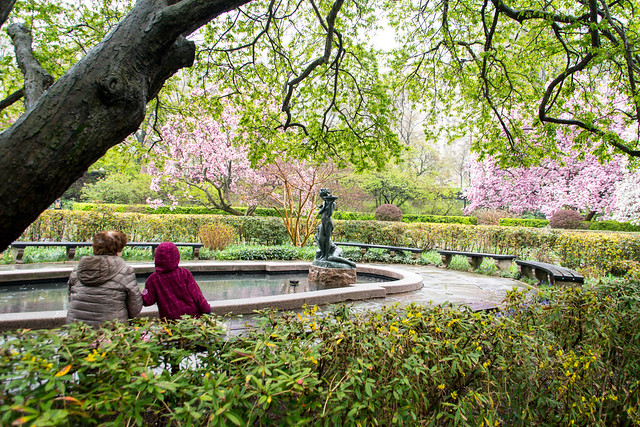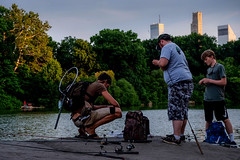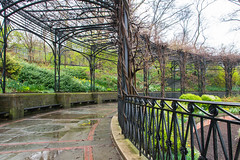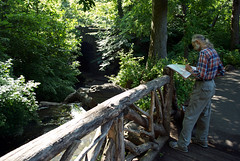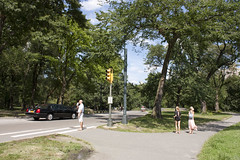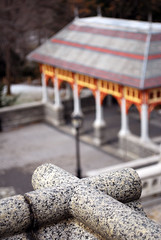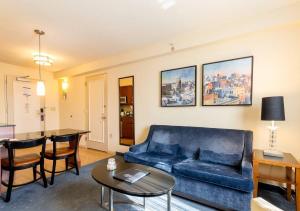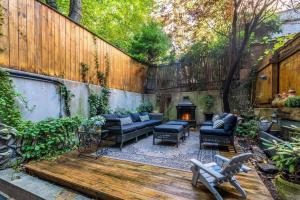Central Park
Central Park is an urban park in New York City located between the Upper West and Upper East Sides of Manhattan. It is the fifth-largest park in the city, covering . It is the most visited urban park in the United States, with an estimated 42 million visitors annually , and is the most filmed location in the world.
After proposals for a large park in Manhattan during the 1840s, it was approved in 1853 to cover . In 1857, landscape architects Frederick Law Olmsted and Calvert Vaux won a design competition for the park with their "Greensward Plan". Construction began the same year; existing structures, including a majority-Black settlement named Seneca Village, were seized through eminent domain and razed. The park's first areas were opened to the public in late 1858. Additional land at the northern end of Central Park was purchased in 1859, and the park was completed in 1876. After a period of decline in the early 20th century, New York City parks commissioner Robert Moses started a program to clean up Central Park in the 1930s. The Central Park Conservancy, created in 1980 to combat further deterioration in the late 20th century, refurbished many parts of the park starting in the 1980s.
Main attractions include landscapes such as the Ramble and Lake, Hallett Nature Sanctuary, the Jacqueline Kennedy Onassis Reservoir, and Sheep Meadow; amusement attractions such as Wollman Rink, Central Park Carousel, and the Central Park Zoo; formal spaces such as the Central Park Mall and Bethesda Terrace; and the Delacorte Theater. The biologically diverse ecosystem has several hundred species of flora and fauna. Recreational activities include carriage-horse and bicycle tours, bicycling, sports facilities, and concerts and events such as Shakespeare in the Park. Central Park is traversed by a system of roads and walkways and is served by public transportation.
Its size and cultural position make it a model for the world's urban parks. Its influence earned Central Park the designations of National Historic Landmark in 1963 and of New York City scenic landmark in 1974. Central Park is owned by the New York City Department of Parks and Recreation but has been managed by the Central Park Conservancy since 1998, under a contract with the municipal government in a public–private partnership. The Conservancy, a non-profit organization, raises Central Park's annual operating budget and is responsible for all basic care of the park.
span class="anchor" id="Design and layout">escription
Central Park is bordered by Central Park North at 110th Street; Central Park South at 59th Street; Central Park West at Eighth Avenue; and Fifth Avenue on the east. The park is adjacent to the neighborhoods of Harlem to the north, Midtown Manhattan to the south, the Upper West Side to the west, and the Upper East Side to the east. It measures from north to south and from west to east.
Design and layout
Central Park is split into three sections: the "North End" extending above the Jacqueline Kennedy Onassis Reservoir; "Mid-Park", between the reservoir to the north and the Lake and Conservatory Water to the south; and "South End" below the Lake and Conservatory Water. The park has five visitor centers: Charles A. Dana Discovery Center, Belvedere Castle, Chess & Checkers House, the Dairy, and Columbus Circle.
The park has natural-looking plantings and landforms, having been almost entirely landscaped when built in the 1850s and 1860s. It has eight lakes and ponds that were created artificially by damming natural seeps and flows. There are several wooded sections, lawns, meadows, and minor grassy areas. There are 21 children's playgrounds, and of drives.
Central Park is the fifth-largest park in New York City, behind Pelham Bay Park, the Staten Island Greenbelt, Van Cortlandt Park, and Flushing Meadows–Corona Park, with an area of . Central Park constitutes its own United States census tract, numbered 143. According to American Community Survey five-year estimates, the park was home to four females with a median age of 19.8. Though the 2010 United States Census recorded 25 residents within the census tract, park officials have rejected the claim of anyone permanently living there.
Visitors
Central Park is the most visited urban park in the United States and one of the most visited tourist attractions worldwide, with 42 million visitors in 2016. The number of unique visitors is much lower; a Central Park Conservancy report conducted found that between eight and nine million people visited Central Park, with 37 to 38 million visits between them. By comparison, there were 25 million visitors in 2009, and 12.3 million in 1973.
The number of tourists as a proportion of total visitors is much lower: in 2009, one-fifth of the 25 million park visitors recorded that year were estimated to be tourists. The 2011 Conservancy report gave a similar ratio of park usage: only 14% of visits are by people visiting Central Park for the first time. According to the report, nearly two-thirds of visitors are regular park users who enter the park at least once weekly, and about 70% of visitors live in New York City. Moreover, peak visitation occurred during summer weekends, and most visitors used the park for passive recreational activities such as walking or sightseeing, rather than for active sport.
Governance
The park is maintained by the Central Park Conservancy, a private, not-for-profit organization that manages the park under a contract with the New York City Department of Parks and Recreation (NYC Parks), in which the president of the Conservancy is the ex officio administrator of Central Park. It effectively oversees the work of both the private and public employees under the authority of the publicly appointed Central Park administrator, who reports to the parks commissioner and the conservancy's president. The Central Park Conservancy was founded in 1980 as a nonprofit organization with a citizen board to assist with the city's initiatives to clean up and rehabilitate the park. The Conservancy took over the park's management duties from NYC Parks in 1998, though NYC Parks retained ownership of Central Park. The Conservancy provides maintenance support and staff training programs for other public parks in New York City, and has assisted with the development of new parks such as the High Line and Brooklyn Bridge Park.
Central Park is patrolled by its own New York City Police Department precinct, the 22nd (Central Park) Precinct, at the 86th Street transverse. The precinct employs both regular police and auxiliary officers. The 22nd Precinct has a lower crime rate than in the 1990s, with crimes across all categories having decreased by 81.2% between 1990 and 2019. The precinct saw one murder, one rape, 21 robberies, seven felony assaults, one burglary, 37 grand larcenies, and one grand larceny auto in 2019. The citywide New York City Parks Enforcement Patrol patrols Central Park, and the Central Park Conservancy sometimes hires seasonal Parks Enforcement Patrol officers to protect certain features such as the Conservatory Garden.
A free volunteer medical emergency service, the Central Park Medical Unit, operates within Central Park. The unit operates a rapid-response patrol with bicycles, ambulances, and an all-terrain vehicle. Before the unit was established in 1975, the New York City Fire Department Bureau of EMS often took over 30 minutes to respond to incidents in the park.
History
Planning
Between 1821 and 1855, New York City's population nearly quadrupled. As the city expanded northward up Manhattan, people were drawn to the few existing open spaces, mainly cemeteries, for passive recreation. These were seen as escapes from the noise and chaotic life in the city, which at the time was almost entirely centered on Lower Manhattan. The Commissioners' Plan of 1811, the outline for Manhattan's modern street grid, included several smaller open spaces but not Central Park. As such, John Randel Jr. had surveyed the grounds for the construction of intersections within the modern-day park site. The only remaining surveying bolt from his survey is embedded in a rock north of the present Dairy and the 66th Street transverse, marking the location where West 65th Street would have intersected Sixth Avenue.
Site
By the 1840s, members of the city's elite were publicly calling for the construction of a new large park in Manhattan. At the time, Manhattan's seventeen squares comprised a combined of land, the largest of which was the Battery Park at Manhattan island's southern tip. These plans were endorsed in 1844 by New York Evening Post editor William Cullen Bryant, and in 1851 by Andrew Jackson Downing, one of the first American landscape designers.
Mayor Ambrose Kingsland, in a message to the New York City Common Council on May 5, 1851, set forth the necessity and benefits of a large new park and proposed the council move to create such a park. Kingsland's proposal was referred to the council's Committee of Lands, which endorsed the proposal. The committee chose Jones's Wood, a tract of land between 66th and 75th streets on the Upper East Side, as the park's site, as Bryant had advocated for Jones Wood. The acquisition was controversial because of its location, small size relative to other potential uptown tracts, and cost. A bill to acquire Jones's Wood was invalidated as unconstitutional, so attention turned to a second site: a area known as "Central Park", bounded by 59th and 106th streets between Fifth and Eighth avenues. Croton Aqueduct Board president Nicholas Dean, who proposed the Central Park site, chose it because the Croton Aqueduct's , collecting reservoir would be in the geographical center. In July 1853, the New York State Legislature passed the Central Park Act, authorizing the purchase of the present-day site of Central Park.
Th…
Hotels Central Park
Looking for places related to Central Park?
Those are other destinations to find places related to Central Park:
- Central Park
- Metropolitan Museum…
- Solomon R. Guggenhe…
- Jacqueline Kennedy …
- American Museum of …
- Upper West Side
- Dakota
- Hayden Planetarium
- Strawberry Fields
- Eldorado
- Jewish
- Neue Galerie New Yo…
- Cooper–Hewitt, Nati…
- Beresford
- Church of St. Ignat…
- Nightingale-Bamford…
- Andrew Carnegie Man…
- American Academy of…
- Astor Court
- Blue Tree
- Congregation Shaare…
- Consulate-General o…
- Mannes College The …
- B'nai Jeshurun
